News items
📍 Looking for Dragonmount at JordanCon? We're all over the place! Come find us to grab your exclusive badge ribbon and join in on the fun. We're excited to meet you, share stories, and celebrate our love for The Wheel of Time. Check our plans and stop by—let's make this JordanCon unforgettable!

Katy is a news contributor for Dragonmount. You can follow her as she shares her thoughts on The Wheel of Time TV Show on Instagram and Twitter @KatySedai Kate Reading and Michael Kramer are the narrators of the Wheel of Time audiobooks and were special guests at the first WOTCon convention last week. WoTCon is a Wheel of Time convention created for and run by fans of the Wheel of Time. The first convention took place July 8-10, 2022 in Columbus, OH. During one of the panels, they performed a live reading of Moiraine’s Weep for Manetheren speech from The Eye of the World, the first book of the Wheel of Time series. Weekly Wheel News recorded the live reading and posted it to their YouTube channel. Check it out here: Anyone need a tissue? Their voices are so incredible and this scene is such an iconic Wheel of Time moment. Let us know what you think in the comments below or on our forums.
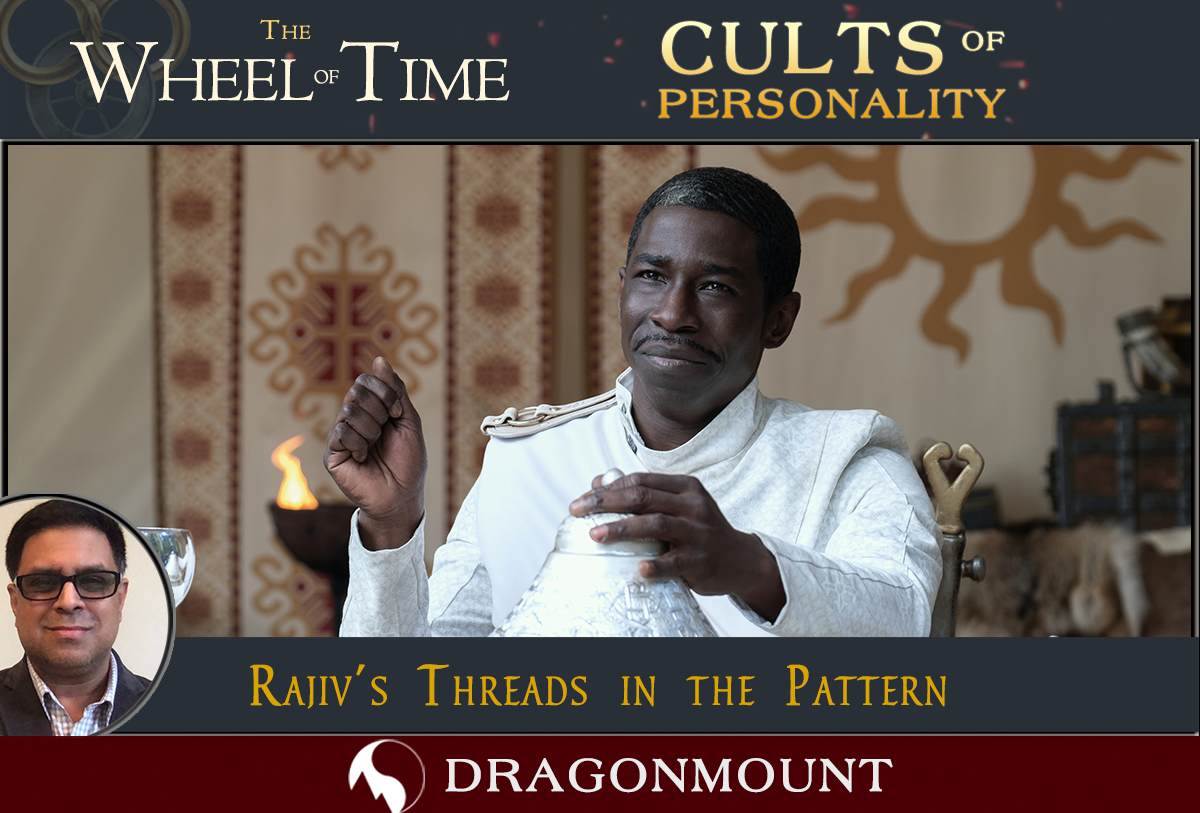
Rajiv Moté is Dragonmount’s book blogger with a lens on the craft of fiction writing. When he’s not directing software engineers, he writes fiction of his own, which can be found catalogued at his website. J.R.R. Tolkien said “all stories are ultimately about the fall,” and Robert Jordan’s The Wheel of Time certainly fits that description. There are neither beginnings nor endings to the turning of the Wheel of Time, but much like the Hindu cosmology on which the Wheel’s cyclical history is based, there is an Age that represents the apex of human civilization (the Age of Legends), and an Age that falls into the nadir, where the Dark One casts his shadow on the world. Apocalyptic stories chronicle the fall. The stakes are whether there is hope of a subsequent rise. While Robert Jordan’s take on the fall of civilization centered around the rise of an evil Dark Lord, it manifested in recognizably political ways. Our own world history shows war and strife following the rise of cults of personality around authoritarian leaders, fanning the flames of a society’s worst impulses. In the story, the road to Tarmon Gai’don was filled with such cults and despots, many of them familiar. Let’s look at a few. The Children of the Light The Children (or Whitecloaks as they’re called when not in earshot) are a military organization answerable to no authority but themselves. Though based in the nation of Amadicia, their Lord Captain Commander holds more power than the Amadician king, and they boast that their authority extends wherever the Light shines. Robert Jordan claimed that religion didn’t exist in his world, because the Creator and the Dark One were evident to all, but the Children are religious zealots, complete with a holy text, The Way of the Light, and an inquisitorial body, the Hand of the Light (or Questioners). We don’t know much about the group’s founder, Lothair Mantelar, but he wrote The Way of the Light and organized the Children during the War of the Hundred Years. It was a brutal, bloody period of chaos following the disintegration of Artur Hawkwing’s empire. During such eras, charismatic leaders offering certainty, purpose, a banner, and an enemy tend to flourish. The Children’s enemies were Darkfriends, but Mantelar also had a useful target in the Aes Sedai. During Hawkwing’s final years (and possibly under Ishamael’s influence), the High King waged war against the White Tower, and his distrust of Aes Sedai was so great he even tried to build a capital around an Ogier stedding, where the One Power could not be used. Given the Dark One’s taint on saidin and Hawkwing’s hatred of Aes Sedai, it would have been easy for Mantelar to harness historical and legendary animosity toward those who wielded the One Power. The glass columns of Rhuidean revealed the willingness to scapegoat and lynch suspected Darkfriends even before the Breaking of the World. The attitude carried forward through centuries, and is reminiscent of the Whitecloak ways. The White Tower While their name translates to “Servant to All” (“public servant?”), the Aes Sedai were a rarified class who lived centuries longer than ordinary people and, of course, could wield the magic power that drove the universe. What we know of the Age of Legends reinforces the idea that they were elites whose status was conferred by an inborn trait, the ability to touch the One Power. The White Tower was founded after the Breaking of the World, during a time of great strife. The Aes Sedai themselves became an even more exclusive group, as all the male Aes Sedai were driven mad by the Dark One’s taint. Since its founding, the White Tower’s mission has been to spread its influence and consolidate its authority. Each Aes Sedai is treated in most nations with the status of a ruler, and the Tower’s premier, the Amyrlin Seat, has been known to command kings and queens. The Tower reinforces its authority by suppressing its failures. Moiraine won Lan’s trust by revealing one of the Tower’s secrets. Into this atmosphere of elitism, arrogance, and secrecy comes the Dragon Reborn. When the Amyrlin Seat Siuan Sanche’s secret dealings with the Dragon Reborn were revealed, a faction of Aes Sedai led by Elaida do Avriny a’Roihan staged a coup and deposed Siuan. Elaida was strong in the One Power among Aes Sedai, which conferred standing. She was also steel-hard, determined, and sporadically possessed of the ability to Foretell the future, if not necessarily understand it, which gave her a disastrous false certainty. She was also almost laughably narcissistic. (I have since been disabused of the notion that someone so self-preoccupied could never achieve such a position of power in the real world.) Mesaana and the Black Ajah couldn’t have picked a better leader to tear the White Tower apart. Elaida reigned through intimidation, threats, and bullying. She seemed incapable of building consensus or coalitions except through appeals to fear or greed. And she devoted a great deal of time and resources to self-aggrandizement, like building a personal palace to rival the White Tower itself. Elaida’s coup broke the Tower into its first open schism that became an all-out civil war. In the context of current events, Robert Jordan’s take on the White Tower’s schism may have been optimistic. While Elaida’s unhinged leadership, and coterie of cronies and secret Darkfriends caused significant damage, Jordan showed that the institution of the Hall of the Tower, as well as backchannel activities of serious-minded Aes Sedai acting for the good of the Tower (and the world), were capable of healing the break. Egwene was instrumental in bringing the White Tower to Tarmon Gai’don on the side of the Light, but she did not act alone. The Dragonsworn If the Children of the Light brought elements of quasi-religious fundamentalism to the world of the Wheel, the Dragonsworn brought full-on, militant, religious extremism. It’s fitting. Rand al’Thor is a figure of religious prophecy, a messianic avatar of the Creator sent to save the world from humanity’s great adversary, the Dark One. The crumbling of nations was foretold; the Dragon’s appearance signaled the End Times, a new global purpose, and an open, literal war between Light and Dark. And in this cosmology, it’s absolutely, beyond-any-doubt true. When Masema Dagar, a soldier who has guarded against the Blight all his life, saw Rand al’Thor in the sky, battling what appeared to be the Dark One, it was a religious experience that filled him with awe and zeal of purpose. In this world, that is a reasonable reaction to the arrival of the actual messiah. But as the Prophet, Masema amassed madmen around him, and became a crazed fanatic. How much of that was due to the disguised Forsaken (probably the proxy-loving Demandred) manipulating him? It’s unknown. Some people are just fanatics in search of a focus. What’s interesting is that the Prophet, much like the Children of the Light’s Lothair Mantelar, invented his own moral code to rally his followers. For the Dragonsworn, extreme austerity, a detachment from worldly concerns, and devotion to nothing but the Dragon Reborn were the hallmarks of their beliefs. None of this came from Rand al’Thor. It became critical to his victory that Rand wasn’t the sort to dictate what was in people’s hearts, but as a religious figure, his refusal to do so created a moral vacuum for those who saw all old ties and purpose burned by the coming of the Dragon. That allowed others--Masema and the Forsaken manipulating him--to fill that void in a way that served the Shadow. The Shaido Aiel Just as the White Tower was sundered by news of the Dragon’s rebirth, the Aiel suffered an identity crisis when Rand proved himself their Car’a’carn by revealing their secret history. Even today, in the real world, people fight bitterly over the history they reveal about their own society. Identity is the stories we tell ourselves about ourselves, and to learn that identity is a lie invites a crisis. When Rand revealed that the Aiel, proud, honor-bound warriors, began as sworn pacifists whose honor was to serve, he revealed that every one of them was one of the worst things an Aiel could be: an oathbreaker. The Tuatha’an, whom they called “lost,” were actually the keepers of the true faith. Some of the Aiel killed themselves to expiate their shame. Some permanently became gai’shain, a temporary status that contained an echo of what the Aiel once were. The Shaido Aiel doubled down on the lie of their identity, rejecting the revelations about their history as falsehoods designed to break them. Their clan chief Couladin claimed to be the Car’a’carn who would lead the Aiel to glory, a lie that many of his people would want to believe over the shame that Rand offered. Couladin offered to Make the Aiel Great Again. Militant fundamentalists, arrogant out-of-touch elites, unhinged narcissist heads of state, religious fanatics, historical revisionists, violent secessionists. If Robert Jordan’s depictions of an apocalyptic age seem prophetic, it’s because he was a lover of history. The Wheel of Time repeats its patterns, and so do world events.
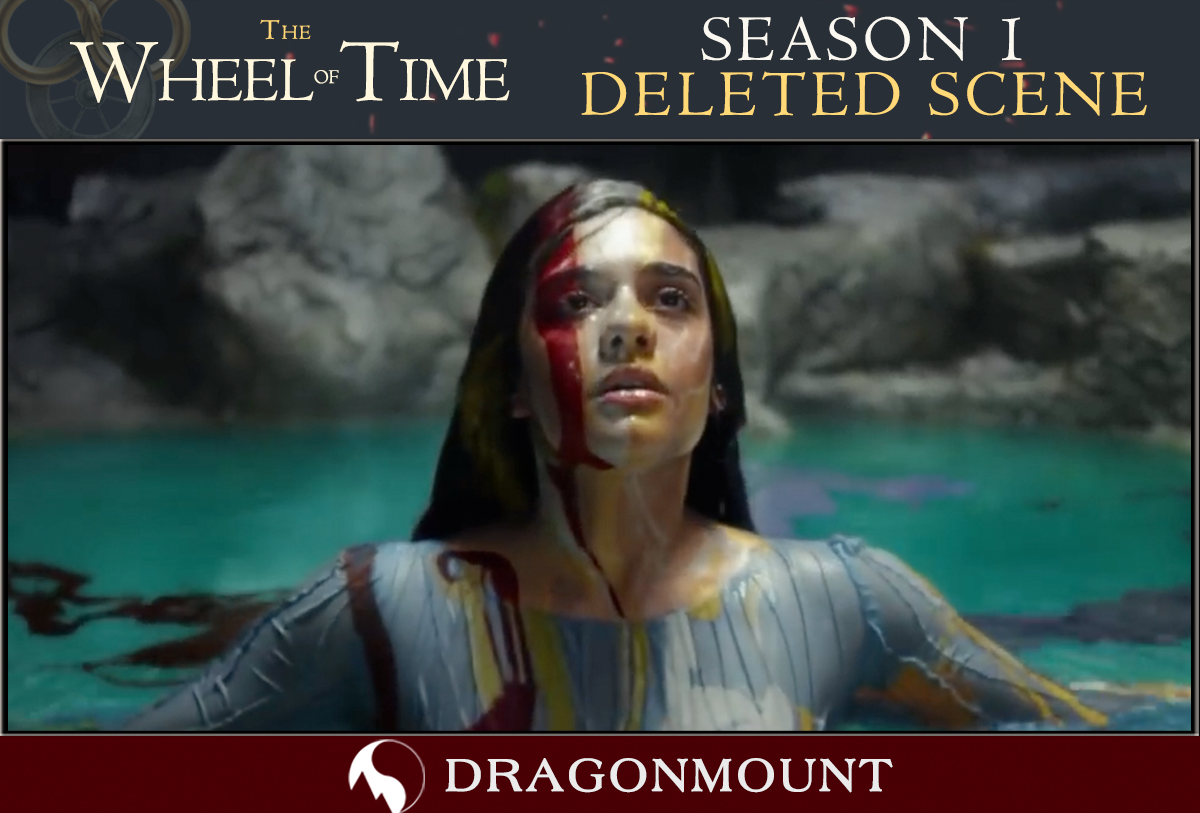
Amazon Prime Video has released the first deleted scene from season 1 of The Wheel of Time TV show on its social media channels. The deleted scene features an alternative version of the events from Episode 1 that take place inside the Women's Circle cave in the Two Rivers. Nynaeve narrates about the role of women in society as Egwene is submerged into a pool with streams of paint. The paint colors correspond to the seven Ajahs. This image was originally teased in the first TV show trailer, but never made the cut into the finished episode. This clip was first revealed at the closing ceremonies of WoTCon, a first-year fan convention that took place in Columbus, Ohio. A day later, it was released on social media. A second clip was also shown at the convention featuring Egwene and Tam al'Thor. (Updated) Here's our reaction video to this deleted scene, featuring Kitty Rallo.
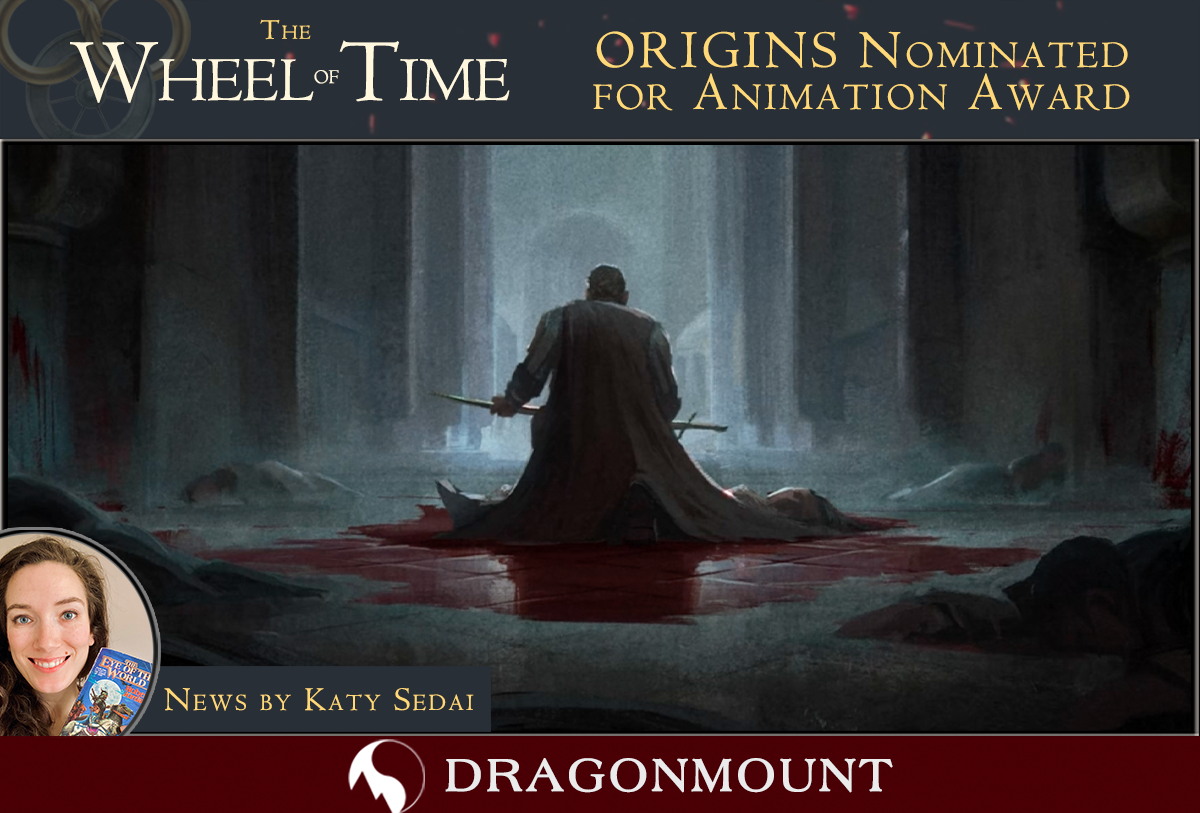
Katy is a news contributor for Dragonmount. You can follow her as she shares her thoughts on The Wheel of Time TV Show on Instagram and Twitter @KatySedai The Wheel of Time: Origins Series has been nominated for Best Animated Short Form Series by the Hollywood Critics Association. The second annual HCA TV awards will be shown on broadcast and cable August 13th, and streaming on August 14th. The Hollywood Critics Association is an organization that is known for promoting diversity of film and television and was the first organization to create separate categories for certain streaming and broadcast television awards. The Origins series debuted on November 19th with the first episode of Amazon Prime’s The Wheel of Time TV show. There are six episodes, each about three minutes long which explores the lore and history of the Wheel of Time story. The Origin series was originally hard to find in the X-ray content on Amazon Prime video, but the shorts can now be found as bonus features on the main menu or in the explore tab. The Episodes are: 1. The Breaking of the World 2. The Fall of Manetheran 3. The Greatest Warder 4. Saidin, Saidar, Stone 5. The White Tower 6. An Ogier's Longing Written by Rammy Park Producer Jakub Chilczuk Director Dan Difelice Animation by MPC Episodic Narrated by Ida May Rupert Degas The Wheel of Time’s social media accounts also recently announced a panel focused the Origin series at San Diego Comic Con on Thursday, July 21st. The description for the Comic Con panel hints that fans will see something special: The writer of the Origins series, Rammy Park posted the news to Instagram and said: I can't wait to see what the Wheel of Time team has in store for us. The animation of the series was beautifully done and it was a great way to introduce TV fans to the background and lore of the Wheel of Time. Be sure to check our the Origin series if you haven't seen them yet! Let us know what you think of them in our forums or in the comments below.
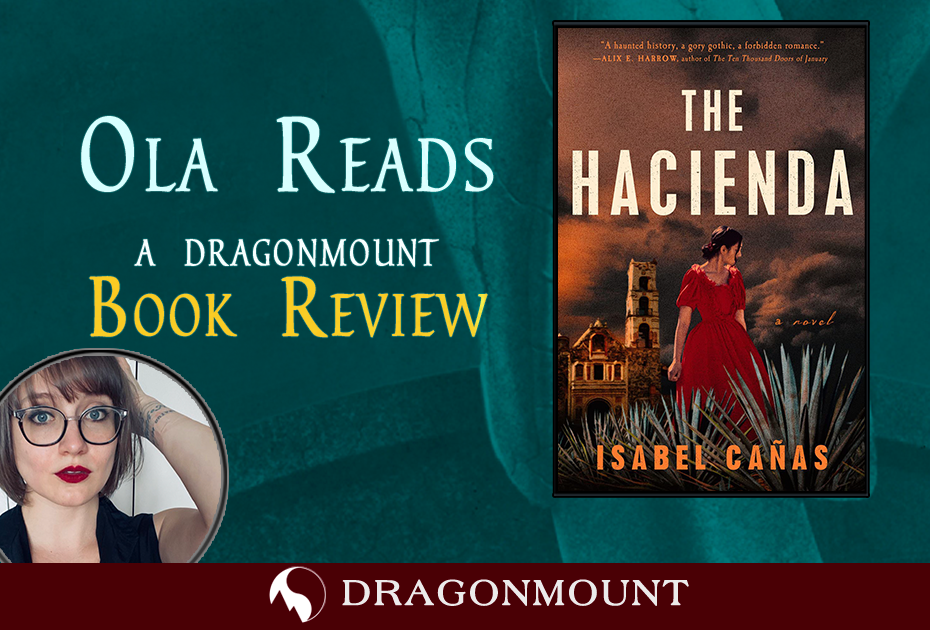
Aleksandra (Ola) Hill is a Polish-Canadian writer and the founder and editor-in-chief of khōréō, a magazine of speculative fiction by immigrant and diaspora writers. She won the grand prize in the 2019 Writer’s Digest Popular Fiction Awards and is currently pursuing an MFA in writing at The New School. You can find her on Twitter at @_aleksandrahill. # TL;DR: The Hacienda by Isabel Cañas is a chilling, genre-bending gothic novel set in the wake of Mexico's War of Independence. Chock full of twists, it's a perfect read for anyone looking for a breathless read, including fans of Mexican Gothic by Silvia Moreno-Garcia, The Haunting of Hill House by Shirley Jackson, and The Book of Cold Cases by Simone St. James. # This column is usually about fantasy. But in late May, I told Jason that I really, really wanted to yell about this new horror book, and could I pretty please do so. He obliged. Readers, I am so excited to tell you about The Hacienda by Isabel Cañas. Pitched as Mexican Gothic meets Rebecca, it tells the story of Beatriz, a young woman whose father was killed in the War of Independence. She and her mother can only find shelter with the disapproving Tío Sebastián and his cruel wife, Tía Fernanda. Beatriz knows her prospects are meager and dimming with every day she stays with her mother’s family, and so, she flees in the only way she can think of: by marrying Rodolfo, a mysterious young widower with an estate far from the city. He spirits her away to his hacienda, San Isidro—and from the first moments, Beatriz realizes that this place is not what she thought it would be. The land is arid; the house is in disrepair; and nobody seems to have any kindness to offer her. Soon, whispers begin to follow her. It is a standard haunted house narrative in that a person is trapped in a house first by their own hand, and then by the situation they have created, and they must learn to fight it lest it destroy them. Cañas captures the crescendo of the experience nicely, beginning with innocuous happenings and slowly bringing the reader and Beatriz herself to realize just how much danger she is in—and just how alone she is in her plight. Even as she finds an ally—more on him in a second—the house has ways of isolating individuals, speaking or acting only towards one person to further undermine their sense of self and leave the reader anxiously awaiting what will happen next. For those looking for an excellent spooky read, this will scratch all the itches you have. But! The Hacienda weaves in so much more depth to the story. Like a typical Gothic novel, Cañas explores the horrors of societal expectations surrounding gender, leaving Beatriz stuck in dangerous situations because of social conventions, expectations, or simply because she is not seen as worth helping. However, the novel also focuses on classism and colorism, how dangerous and impossible power imbalances can be for the disenfranchised individual, religious zealots/pharisees, and the shape and impact of political revolutions. Each of the subplots and the themes they explore weave together into the main plot in a masterful way, making the story feel rich and complete. Perhaps my favourite part of the novel is one of the quieter question that many haunted house stories stop short of asking, let alone answering: what does it mean to find safe harbour after the violence and chaos of everything else that has passed? You’ll have to read and find Cañas’ proposed answer. Although I loved the book, I do want to note that the beginning read a little slow to me. This was in part because of the shifting perspectives. The appeal of gothic fiction to me rests, in part, from only seeing it through one person's eyes—especially as that person begins to question everything that happens and, eventually, their own sanity. To see the world through another character's lens was strange at first; it felt almost like cheating because I could see pieces of the puzzle I didn't feel like I should have access to yet. Perhaps because of this, I didn't initially click with the other point-of-view character: Andrés, a young witch who had grown up in San Isidro before fleeing into priesthood to avoid being caught by the Inquisition, and Beatriz's primary ally throughout the book. If you find yourself in this position, I implore you to continue reading through it. Trust me: this book has one of the most perfect endings I have seen in a novel and it works primarily because of the dual perspective. I spent the last hundred and fifty pages curled motionless in an armchair; it feels like it's meant to be finished in one breathless sitting. I had already planned to recommend the book, but it was its ending that cemented the novel. Additionally, I also found Andrés' perspective growing on me throughout the story because it allowed me to learn about the house's past through a perspective that feels unique to horror. So often, houses are described as evil from the start, or not remembered as anything else. But Andrés shows us the love one can feel for a home that is now haunted and broken: There is something both magical and heartbreaking in seeing San Isidro through past and present, and witnessing the growth and change of Andrés and his power as well. His homecoming brings to mind the first moments of Rand's reunion with someone he thinks at first is a stranger at the Stone of Tear—long-awaited, desperately needed, and, in its initial moments, shockingly brutal. By providing two perspectives for the story, Cañas evolves the book beyond its Gothic roots, allowing her to address larger questions of home, family, and trust in ways that could not have occurred otherwise. I absolutely loved this book and recommend it wholeheartedly for anyone who wants a delightfully chilling read. Cañas uncanny ability to weave the social realities of Beatriz's world into the supernatural horrors of the book makes the world feel lived in and real, rendering the things that go bump in the night that little bit scarier. I hope you love it as much as I did.
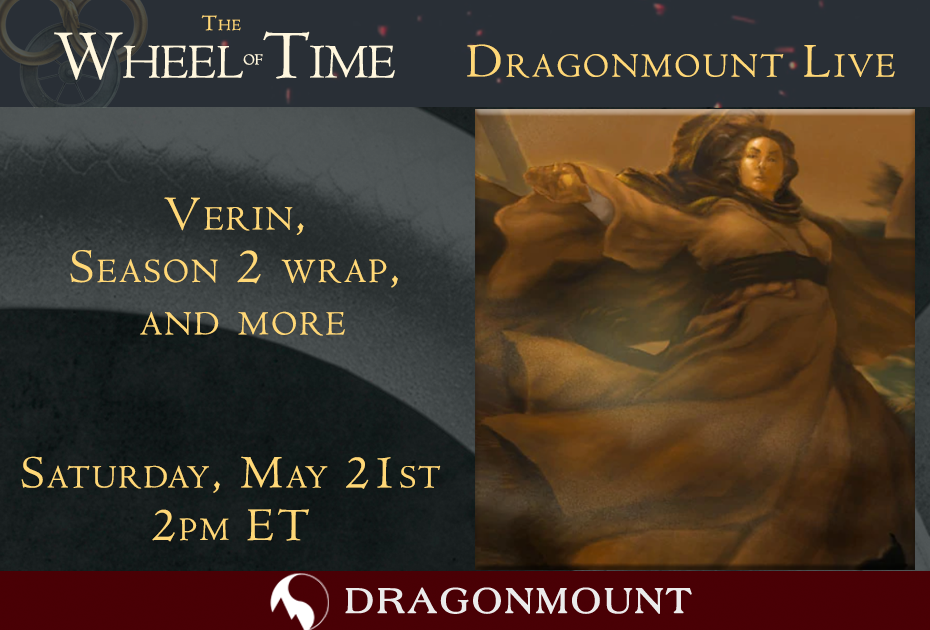
Image credit: “Verin in Emond’s Field” by Benjamin Roque Dragonmount Live is back! Join Thom DeSimone and guest host Maureen Carr as they talk about the latest Wheel of Time news. Topics will include Verin—book Verin and potential show Verin—and the breakings news of Season 2’s wrap. Watch Dragonmount Live on our Instagram feed, Saturday, May 21st, at 2pm ET!
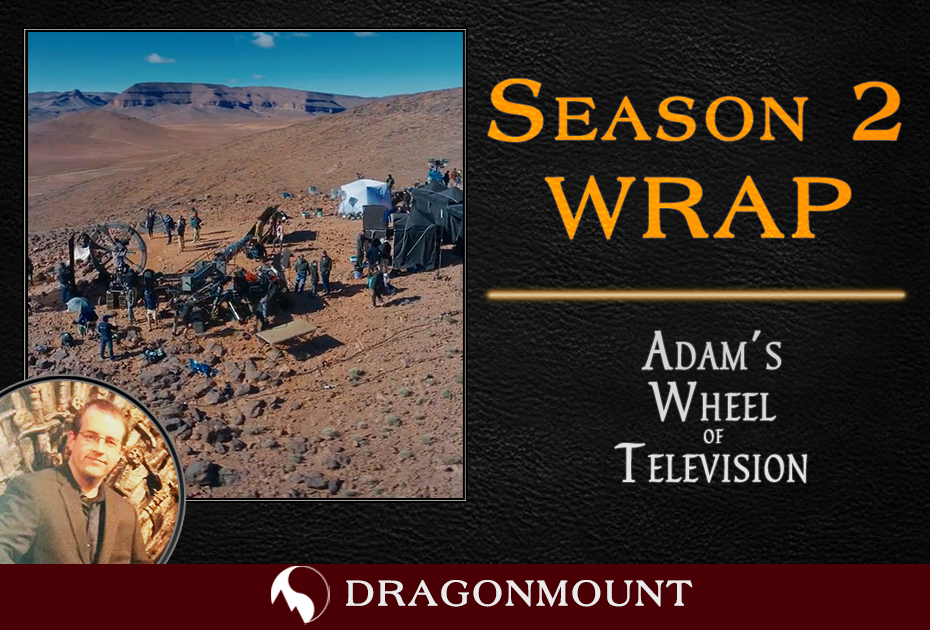
Adam Whitehead is Dragonmount's TV blogger. Adam has been writing about film and television, The Wheel of Time, and other genre fiction for over fifteen years, and was a finalist for the Hugo Award for Best Fan Writer in 2020. Be sure to check out his websites, The Wertzone and Atlas of Ice and Fire (including The Wheel of Time Atlas!) as well as his Patreon. The Wheel of Time has wrapped production on its sophomore season on Amazon Prime. Amazon made the formal announcement today. Season 2 began shooting on 19 July 2021, meaning the production of the second season took ten months in total. That’s a huge improvement on Season 1, which shot for twenty months from 16 September 2019 to 14 May 2021. The immense shoot was, of course, delayed by the COVID19 pandemic, which resulted in two breaks in production for lockdowns and filming suspensions. Despite rumours circulating, Amazon has not so far formally greenlit a third season. They have also not confirmed yet when Season 2 will air. The second season is always an interesting time for a TV show, either allowing it to build on the successes of the first season and become even bigger or failing to maintain the audience and excitement from the debut season, which can put it on the path to cancellation. Second seasons can be rough. Producers and writers might have several years to write the first season (or the pilot) and just months or even weeks to write the second season. Sometimes writers just want to repeat themselves from Season 1, leading to accusations of resting on their laurels (the fate of many a Star Trek sophomore season). Sometimes writers decide to throw in a whole ton of new characters, sometimes at the expense of the original cast, leading to criticism (arguably the fate of Lost and Heroes). Sometimes the writer will go really left-field and set the second season in a different location to the first, following different storylines and leaving behind characters and stories from the debut. David Simon pursued this course with The Wire, to the annoyance of not just fans and critics, but also some of his best actors who found themselves with a lot less to do. Of course, in the long run the move was vindicated. For True Detective, which changed absolutely everything including the entire cast, it was not. Other shows thrive in their second season. They take on board the lessons learned from the first, tighten up the storytelling, maybe lose the stand-alone scene and character-setting episodes from the debut year and move forward with greater verve and confidence. Shows like Babylon 5 and Buffy the Vampire Slayer made absolutely massive strides from their first to second year, upping the quality of writing and storytelling in a huge way and sometimes delivering a season that would go on to be regarded as the best of the whole show. Agents of SHIELD – on which a certain R. Judkins worked as producer and writer – famously had a divisive first season followed by a blistering second season which threw together a whole bunch of great concepts (Hydra, Inhumans and two factions of SHIELD) and moved with tremendous pace and skill, and was credited with saving the show and ensuring it went on for a full seven-year run. For The Wheel of Time, it’ll be interesting to see how the scales fall. And, of course, as an adaptation of a book series, it has its own unique challenges to handle. The first challenge will be integrating the new cast of characters with the cast from the first season. To some extent this problem has been reduced because many characters who debuted in the second novel have already shown up in Season 1: Siuan Sanche, Liandrin and Alanna Mosvani are good examples of that. This means that Season 2 can focus on introducing a smaller cast of new characters, since some of the heavy lifting has been done for them. There are a few counter-examples though, of Book 1 characters who have been delayed to Season 2 (like Elyas Machera and Elayne Trakand), and even Book 3 characters who are being introduced this season (most notably Aviendha). With only eight episodes to work with, the show has to be careful on how it divides its attention between its existing cast and the newcomers. Part of this will also be integrating Dónal Finn as the new actor playing Mat Cauthon (after Barney Harris’s departure during the filming of Season 1), giving him time to settle into the role. To this end, Wheel of Time can take some tips from the second season of Game of Thrones, which also brought in a substantial number of new characters (Stannis, Melisandre, Roose Bolton, Davos, Margaery Tyrell, Brienne) and was able to make them as popular and enjoyable to watch as the (quite large) existing Season 1 cast. However, Wheel of Time has a bigger challenge as well. With the show likely to only last seven to eight seasons of eight episodes apiece, the show has more than twice as much book material as Game of Thrones to cover in fewer episodes. With Season 1 almost wholly restricting itself to material from The Eye of the World, Season 2 will probably cast its net further afield and adapt elements from not just The Great Hunt but also The Dragon Reborn, and maybe even other books in the series. Doing so in a coherent manner will be challenging to the writers. It will also be a challenge to some of the fans. The first season of The Wheel of Time attracted reasonable critical reviews and a strong audience for Amazon, but some devoted fans of the books struggled with the deviations from the text, in characterisation, the changing of plot points or worldbuilding details. Season 2 will probably have no choice but to take the TV series even further away from the books in terms of fidelity to the source material, as it has to adapt a broader range of material from more books. Inevitably, fan-favourite characters and storylines will not make the cut. Season 2 should benefit in one area: how it handles production during a pandemic. Season 1 was three-quarters shot when the COVID19 pandemic shut down production for several months, before shooting on Season 1 could wrap under heavy quarantine restrictions. It’s clear that the crew were scrambling to implement restrictions and make them work whilst also maintaining a crisp and efficient filming schedule. For Season 2 they were much more prepared for this kind of filming, which hopefully should have helped make things go more smoothly. The second season of The Wheel of Time does not have a release date yet. As usual, we will keep you informed of all the relevant details. For more information, visit our TV show section of the website. As usual, please continue to follow developments on our casting and news pages, and the forum, and stay tuned for more info as we get it.
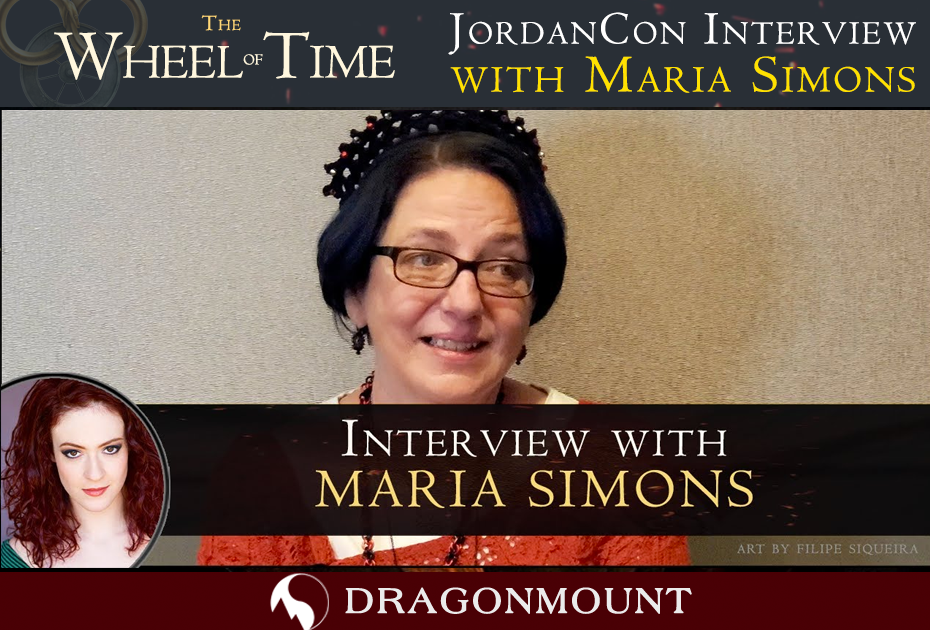
JordanCon 2022 wrapped up a few weeks ago, but that doesn't mean we're out of content! Kitty Rallo got an opportunity to sit down and chat with Maria Simons, of Team Jordan, to get some inside information. Maria shared her start with joining Robert Jordan as an office assistant, and how her role evolved over the years. You can check out the full video here: For those who have been fortunate enough to chat with Maria, you can easily see how much of a treasure she is! Do you have a meeting Maria story you'd like to share? Let us know in the comments!
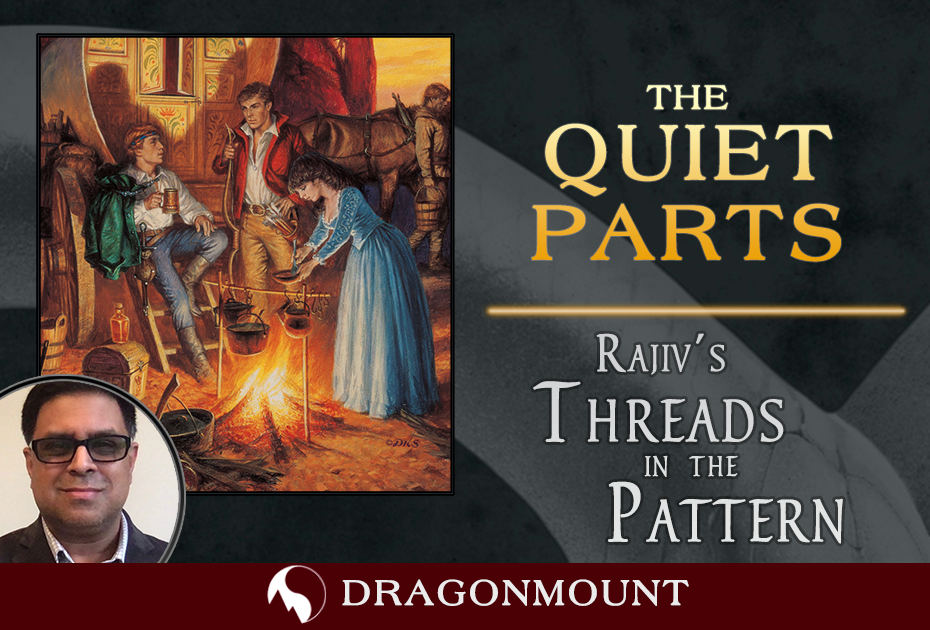
Rajiv Moté is Dragonmount’s book blogger with a lens on the craft of fiction writing. When he’s not directing software engineers, he writes fiction of his own, which can be found catalogued at his website. As the Four Horsemen of the Apocalypse rampage across the news headlines, there is a trend in fiction circles gaining traction with those who seek respite in imaginary worlds. “Cozy fantasy” is a sort of comfort food genre where conflict is minimal, the stakes are low, and endings (if not beginnings and middles) are, well, cozy. Travis Baldree’s Legends and Lattes is about an Orc barbarian who retires to open a coffee shop. Wyngraf, a new, online fantasy magazine is devoted to cozy fantasy and explains the genre’s parameters and inspiration on their site. An upcoming fantasy magazine, Tales & Feathers, plans on publishing “slice of life” fantasy to “luxuriate in the vignette and celebrate quiet beauty.” Fans of the fantasy genre know that the quiet moments have long been a secret pleasure in even the most high-stakes, battle-to-save-the-world stories. The journey is long, hard, and dangerous, but there are places of safety and comfort--however temporary--along the way. It’s usually when our heroes have time to reflect and gather themselves that they find the courage and stamina to press on. Other Dragonmount articles discuss treatments of home and how prologues and epilogues help address the smaller, beloved plot beats. (I have a cozy, quiet story published in Wyngraf #1 called “Epilogue” that explores the themes in those two Dragonmount articles.) “Cozy” often works in a story as an antidote for hardship. It is the contrasting texture that keeps an otherwise grim tale from numbing the reader. We, like the characters, require rest and solace, a chance to give our adrenal glands a break. We need a reminder of the good in the world worth fighting for. Samwise Gamgee said it best in the movie adaptation of The Two Towers. It remains to be seen if a purely cozy fantasy can stand on its own without a contrasting aesthetic to “earn” it--in the story itself or in the reader’s real life. But in a rich, textured story, the quiet parts are often the ones that stay with us and reveal the most about our favorite characters. The Wheel of Time has many quiet, cozy moments that remain among my favorite scenes. It’s interesting to examine them to figure out why they’re so effective, so I’m going to put one such scene under the lens for each of our major protagonists. Rand al’Thor One of my favorite sequences in The Eye of the World, if not the entire Wheel of Time, is where Rand and Mat are on the road to Caemlyn, surviving on their wits, modest skills, and sheer luck. A Myrddraal is in pursuit. It has seemingly killed their protector and mentor, Thom. Darkfriends are everywhere. A stop along the way is the Grinwell farm, which the Amazon Prime adaptation rendered as a horror sequence, but the book rendered rather cozy. In exchange for a day’s labor, the farm became a place of safety and comfort, but only temporarily. Rand and Mat, through hard work and new skills they’ve learned from Thom, manage to earn a hot meal and a bed, but Mistress Grinwell is firm that they get an early start the next day. The stakes--food, shelter, and safety--are basic. The threats--an amorous farmer’s daughter and her protective mother--are gentle. Still, there are moments of healing, mourning, joy, romantic tension, and resignation to the danger yet to be faced. It gives us a look at Rand’s proper upbringing, and a sense of how he’s growing as an independent man under his own steam. I’ll give Rand two scenes, on account of Lews Therin. Near the end of the series, this scene is a different kind of quiet: a fascinating encounter with his Ages-old enemy. No threats, temptation, or bullying from the Betrayer of Hope this time around. All that remains is the Last Battle. Moridin/Ishamael/Elan Morin Tedronai is tired, and has nothing left but despair and nihilism. The hope that Ishamael betrayed first was his own. There is no reconciliation or sympathy here: Rand and Moridin remain enemies bent on each other’s destruction. But it’s still a moment of understanding more than open conflict. The scene quietly reveals what the Dragon and the Nae’blis represent: hope vs. despair. Perrin Aybara Quiet moments are where Perrin shines, and he has many beautiful ones. His return home in The Shadow Rising, and his marriage to Faile, are what made Perrin my favorite character of the series. But the moment I chose is earlier, in The Dragon Reborn, when he takes some time to work in a smithy, and Faile sees him for who he truly is. The scene (edited for length, as are all of them) is full of blacksmithy details, from the perspective of a young man who wanted this life. It reveals so much about his character through point of view and action. One of my favorite ways for characters to be revealed is to show them operating inside their expertise, even (or especially) when that expertise is tangential to their destiny. The world and the Wheel have chosen a different path for Perrin, but here we see Perrin take a rest by immersing himself in the work he loves, and being the man he is. Best of all, Faile sees Perrin for what he is, at his core--the hidden stakes of this scene. Not only did Perrin acquire a hammer to counterbalance his axe, but he gained a person who understood what he was, apart from what he must be. This is the scene that cemented Perrin’s character in my mind, and made him my favorite. Mat Cauthon Trouble and conflict always seems to follow Mat, even when he’s out trying to enjoy himself. Mat is often the comic relief as he drinks and gambles with his friends, especially Birgitte, but the most “Mat” moment for me was when he and his men indulged in a night of dancing. The only stakes here are Mat’s pride in front of his men with a woman who can talk circles around him. In this kind of “battle,” Mat manages it so everyone wins. It’s a fun scene that takes care of a lot of exposition about Mat’s memories from other men’s lives and the results of his encounters with the Aelfinn and Eelfinn. But it’s also about Mat flirting and having fun, being thrown off balance by a savvy barmaid, and evening the scales by dancing with her well. It sets up Mat, the military genius, the master of shifting tactics, in a light, joyful scene. This is another scene of a character operating inside their expertise: Mat intuitively uses all his knowledge and luck to change the dynamic to his advantage. It manifests later in his courtship of the Daughter of the Nine Moons, and in every battle he leads. Egwene al’Vere Before she became burdened with duty and politics, Egwene had some wonderful scenes with her friends in the White Tower, supporting each other, conspiring together, and having each other’s backs. But I always return to Egwene from The Eye of the World, having her first taste of independence away from home by the Tinkers’ fires. There are parallels with Rand’s time on the road--indeed, Rand and Egwene are on parallel journeys--but Egwene embraces the world, and learns anything and everything she can from the cultures she encounters. Egwene was the one member of the Emond’s Field Five eager to go out into the world. At this point, she is all but betrothed to Perrin’s best friend Rand, and they don’t even know if Rand is alive. Perrin sees what Rand saw, interpreting her eagerness for the wider world as a rejection of the smaller one they cling to, and it hurts. But Egwene won’t be constrained by sentiment. Joseph Campbell’s Hero’s Journey may require the hero to be initially reluctant, but Egwene’s Heroine’s Journey has her answering the call to adventure without a backward glance. Nynaeve al’Maera While Nynaeve mustering the Borderlanders in preparation for Lan’s journey to Tarwin’s Gap was quietly epic, the scene that made me understand (and love) Nynaeve was in The Dragon Reborn, where she matched her knowledge of “the craft” with an herb woman to win her trust. This scene is another example of characters operating within their expertise, and it’s especially poignant with Nynaeve, because her pride in her expertise as a Wisdom blocks her from starting as a beginner in the Aes Sedai arts. It’s harder because she gets a lot of mileage out of what she already knows. She can gain Mother Guenna’s trust, she can speak in coded language in a country where women are persecuted for being connected with the Power, and she’s confident enough in her knowledge to admit ignorance on certain details (which confirms her expertise). The stakes are not only gaining an ally and place to stay in Tear, but Nynaeve’s own self image and confidence. Ironically, the more she wins as Nynaeve the Wisdom, the farther she gets from Nynaeve Aes Sedai, and the realization that she has much to learn to reach her potential. What are your favorite quiet moments in epic fantasy?

The annual Robert Jordan Memorial Scholarship is open at TarValon.Net. Each year, TarValon.Net offers $500 scholarships to those pursuing higher education. Here are this year’s details: You can apply by following this link. Let us know how you’d be a Servant of All to your community in the comments below!

JodanCon Day 3 is the saddest! It’s time to say goodbye to friends and family. It’s time to leave the hotel that offered us sanctuary for the past few days. It’s time to put our costumes in the closet until next year (or the next local con). Sunday feels bitter-sweet. Looking back over the weekend, we had the time of our lives, but all good things must come to an end. Here are some highlights from today. Matt Hatch recorded a live Dusty Wheel episode in the lobby. This amazing event—with lots of fan participation—is worth a watch. You can see all of Matt’s JordanCon videos here. The Wheel of Time Track had a panel on ranking our favorite scenes in the Amazon Prime Video television show. Our own Kathy Campbell, as well as Maria Simons, gave their expert opinions. The Charity Auction and Art Show Auction wrapped up. Winners collected their items, or suffered the bitter taste of defeat. I was so so happy to win a beautiful mixed medium artwork called “The Colors of My Sisters,” crafted by Lori of Morrow Makings. I was looking forward to teaching a cross-stitching class and it did not disappoint! We had a great turn out and got to pass along our Wheel of Time 8-bid designs. We’ll have to do it again next year. Finally, JordanCon is a charity. Any money raised is donated. This year’s recipient was the Mayo Clinic, to aid in the research of amyloidosis, the disease that took Robert Jordan from us. This year, $19,800 was raised! $13,500 was from the charity auction! The signed script page was auctioned for $1,055. We did amazing! I love how the fandom cares so deeply about giving back. If you attended the con, please make sure to leave feedback by following this link. Now the con is over and it’s back to our daily lives. Hopefully we’ll be getting season 2 of the television show to tide us over until next year. Until then, keep up to date with Wheel of Time news and announcements by following us on Facebook, Instagram, and Twitter.
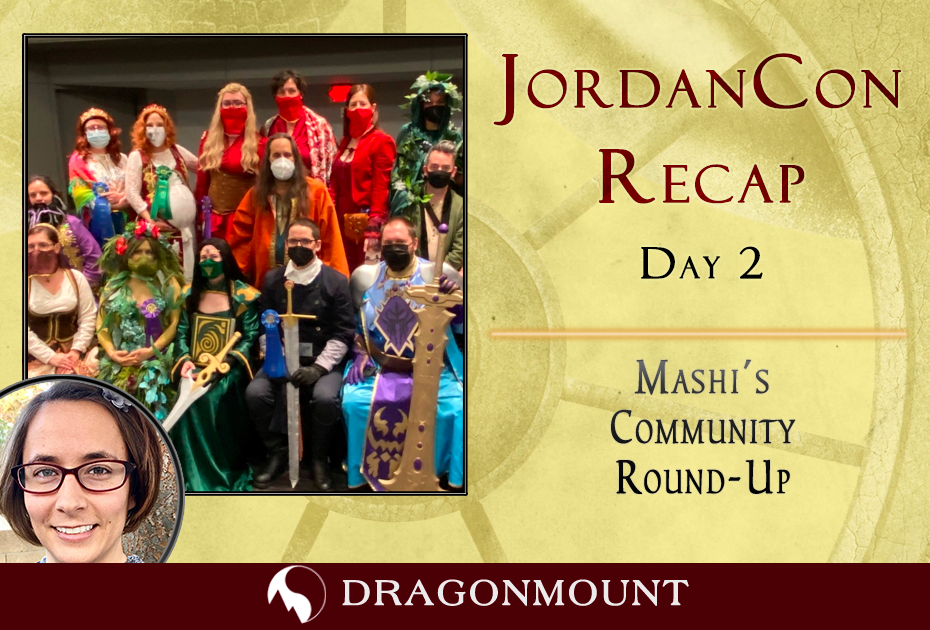
JodanCon Day 2 is the best! It’s the only full day (unless you count CouchCon after the closing ceremonies) and that means it’s packed from morning to evening. The annual costume contest falls on Saturday, so the cosplayers were out in droves. Wheel of Time cosplays are expected. https://twitter.com/AielMelindhra Brandon Sanderson and cosmere are expected. And at JordanCon, other fandom tie-ins are also expected. https://www.facebook.com/42bananas?__tn__=-UC*F Nothing is off limits for this fandom! Keep that in mind for next year. If you're hesitating over a costume idea, don't. And speaking of the costume contest, here are the highlights. Judges' Choice: Judge Leslie: Jessica Jones as Pregnant Elayne Judge Redfield Designs (Kathryn Paterwic): Ruth Carnejo as Egwene at the Last Battle Judge Deana: Ris Harp as Blackbeard (from Our Flag Means Death) Found Object: tWoTCast and Taffy Bennington as The Best Hedge Rand and Mat Slept Under Workmanship Award: April Davis as a Nym Winners: Novice: Liz Willoughby as Bright and Fun Tinker Journeyman: Chris Orndorff as Steampunk Ursula Master: Seth Lockhart, Kate Helmly, Stephen Helmly, and Steph Greear as Heralds (from Rhythm of War) Best in Show: Marcos Romero, Sita Romero, Theo Romero, and Brandee Anderson as Logain Ablar, Liandrin Sedai, and Red Aes Sedai https://twitter.com/LeisaSedai Justin Gerard—one half of this year's Artist Guest of Honor—had a live drawing panel. The end result was an amazing Trolloc. Dragonmount's own Rand al'Thor made an appearance. Check out TikTok for all the videos. Another Rand variant also put on a display. Paul Bielaczyc reenacted the (in)famous cover of Lord of Chaos. I spent my time today talking about detectives in urban fantasy and attempting to crochet a Doomslug—well, technically a friend of Doomslug. One amazing thing about this convention is there is something for everyone. Tomorrow, I am teaching a Wheel of Time cross-stitching class in the Makers Track. I can’t wait to show pictures from that! Sunday’s coming on fast, but there’s still plenty of JordanCon left to indulge in. Follow along to see me and other Dragonmount staff on Facebook, Instagram, and Twitter. Which costume contest participant was your favorite? Let us know in the comments below.
-Dragonmount-Banner-Ads-1200x280.gif.ed90097d91aa5c65a5c17fab3b59c6f2.gif)
-Dragonmount-Banner-Ads-728x90.gif.a2f99d762ad611c51fbffc8b25a4efb4.gif)
-Dragonmount-Banner-Ads-320x100.gif.a233f9b759ce2a0c82ee7b9e890e85dd.gif)













.jpg.b7a8ed0c6c6b6db6eaa89411a06d40a5.jpg)
.gif.42a259ec4461f639cc9bc78adbc6ff0e.gif)